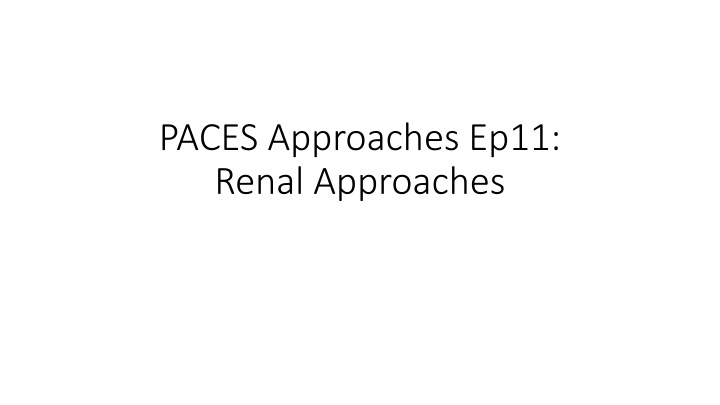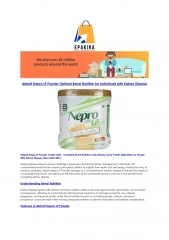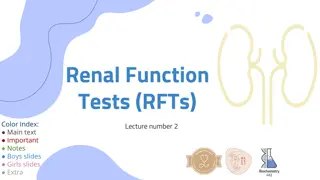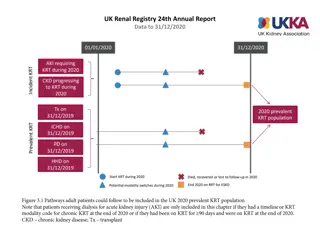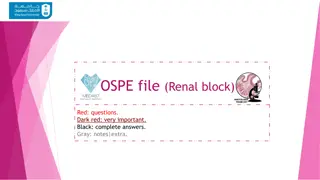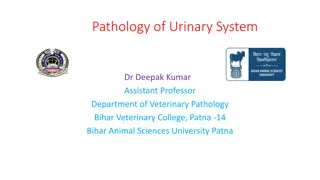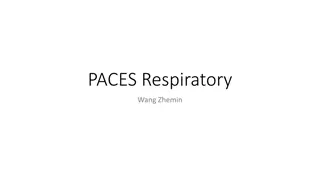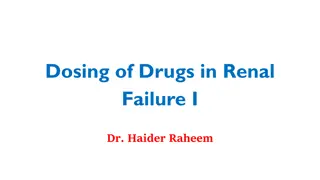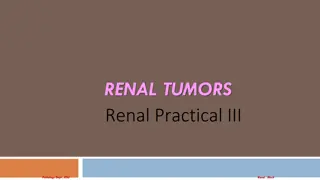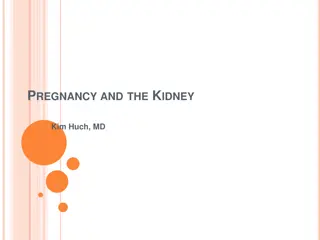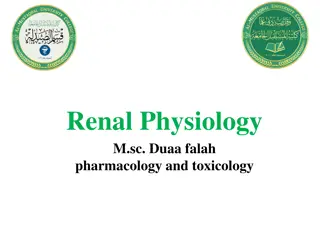PACES Approaches Ep11:Renal Approaches
The content discusses various approaches in managing acute kidney injury, including pre-renal causes, renal conditions, post-renal obstruction, infective, inflammatory, neoplastic, endocrine, and drug-related factors. It covers complications such as uremia, fluid overload, electrolyte disturbances, and anemia. The investigations involved, including basic tests and detailed work-ups, are also outlined.
Download Presentation

Please find below an Image/Link to download the presentation.
The content on the website is provided AS IS for your information and personal use only. It may not be sold, licensed, or shared on other websites without obtaining consent from the author.If you encounter any issues during the download, it is possible that the publisher has removed the file from their server.
You are allowed to download the files provided on this website for personal or commercial use, subject to the condition that they are used lawfully. All files are the property of their respective owners.
The content on the website is provided AS IS for your information and personal use only. It may not be sold, licensed, or shared on other websites without obtaining consent from the author.
E N D
Presentation Transcript
PACES Approaches Ep11: Renal Approaches
Approaches Acute Kidney Injury Haematuria Urinary Frequency
Acute Kidney Injury Pre-Renal Hypotension, sepsis, diuretics, cardio-renal/hepato-renal Renal artery stenosis ACEi, ARB Renal Glomerular Refer to GN section Vascular Vasculitis, HUS/TTP, IE, scleroderma renal crisis Tubulointerstitial ATN: Sepsis, drugs (iodinated contrast, aminoglycosides) AIN: Drugs (penicillin, NSAIDS), infections, CTD (SLE, sjogren s) Other insults: Urate nephropathy (tumour lysis, gout), drugs (acyclovir, chemo), rhabdo Post-Renal (Obstruction): Stones, malignancy, BPH, infection Usually bilateral obstruction or unilateral obstruction in single functioning kidney
Acute Kidney Injury Infective: HUS/TTP, IgA nephropathy (synpharyngitic), post infective GN, infective endocarditis Inflammatory: SLE, Vasculitis, Pulmonary-Renal syndromes, Scleroderma, Sjogren s Neoplastic: Cancers a/w membranous glomerulopathy, myeloma, tumour lysis syndrome, urological malignancies Endocrine: DKA/HHS Metabolic: Urate nephropathy, pigment (rhabdomyolysis), phosphate nephropathy Drugs: NSAIDs, antibiotics, contrast, chemotherapy Congenital: - Systemic: Cardio-renal, hepato-renal, pulmonary-renal syndromes
Complications Uremia: Lethargy, confusion, gastritis, bruising, gastritis Fluid overload: Orthopnea, PND, pedal edema, reduction in urine output Electrolyte disturbances Anemia
Investigations Basic: U/E/Cr, FBC (eosinophilia for AIN, thrombocytopenia for HUS/TTP, SLE), LFT (hepatorenal), CK (rhabodo) UFEME, urine PCR US KUB (CT KUB if concerned about calculi), PVRU/bladder scan GN work up: ANCA, ANA, Hep B/C, HIV, myeloma screen Thorough drug history Renal biopsy
Haematuria Mimics: Beet root, medication (rifampicin), pigment (myoglobinuria), obstructive jaundice, menses Coagulopathy: Connective tissue, platelets, coagulation Urological (pelvi-caleceal, bladder, ureter, urethra, prostate): Malignancy, stones, infection, hemorrhagic cystitis, APKD Glomerular Refer to Nephritic Syndrome section
Glomerulonephritis Nephritic Syndrome - Haematuria/Cast, AKI, hypertension Autoimmune: SLE Pulmonary Renal Syndrome: Goodpasture, Wegener s Infective: Hep B/C, HIV, IgA Nephropathy Nephrotic Syndrome Proteinuria, hypoalbuminuria, hypotension, hyperlipidemia, a/w clotting tendencies DM Infective: Hep B/C, HIV Autoimmune: SLE Malignancy: A/w membranous nephropathy, myeloma
Urinary Frequency Lower Urinary Tract Symptoms (Frequency, incontinence, nocturia, hesitancy, terminal dribbling, double voiding) Urological (check for haematuria too): BPH, stones, UTI (dysuria), bladder/urothelial cancer Neurological: Spinal cord, autonomic dysfunction, Parkinson s disease, congenital disorders (spinocerebellar ataxia, spina bifida) Drugs: Anticholinergics Polyuria (>3L per day) Polydipsia: Mouth dryness (Sjogren s, anticholinergic medications), Psychogenic Diabetes mellitus (other causes of solute diuresis) Diabetes insipidus Nephrogenic: Hypercalcemia (MEN, sarcoid, malignancy), Lithium Cranial (important to screen other pituitary symptoms): Trauma, ICH, surgery, neoplasm, vascular event Drugs: Diuretics
DI Work Up Key principles: Osomotic diuresis urine osm higher (>600), urine in polydipsia driven polyuria is appropriately dilute (<300), urine in DI driven polyuria is inappropriately dilute (<300) Water Deprivation Test/Hypertonic Saline Test (DI vs polydipsia): Urine would become concentrated in polydipsia but not DI (remains <600mOsm/kg at 8- hour mark) DDAVP Challenge: Nephrogenic: No response to DDAVP Cranial: Responds to DDAVP (urine becomes concentrated) - >600 mOsm/kg; hence can treat with intranasal desmopressin
